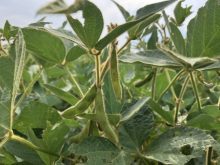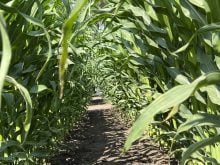It’s become a familiar story in Manitoba. If growers have a choice between soybeans and another crop, beans usually win out.
Such is the case this spring with sunflowers. Soybeans will set another acreage record and sunflowers will possibly hit the second lowest level ever in the province.
Statistics Canada has predicted 50,000 acres of sunflowers in Canada, almost entirely in Manitoba.
The National Sunflower Association of Canada is hoping acres are slightly higher, maybe 60,000, but acreage will definitely be lower than last year.
Read Also

Final crop reports show strong yields, quality
Crops yielded above average across the Prairies this year, and quality is generally average to above-average.
“We did assume that was going to come, knowing that some of our competitive crops are having higher acreage,” said executive director Darcelle Graham.
Sunflowers are more challenging to grow than soybeans, mostly because it’s difficult to manage diseases such as sclerotinia.
Growers will tolerate the additional management because the crop can be highly profitable, but the market for sunflowers is softer this year. Growers in North Dakota and South Dakota, the two biggest producers of sunflowers in the United States, had a huge crop in 2016 and the carryover is weighing on prices.
“We had some producers here that had basically two years crop in one year. That’s how high their yields were,” said John Sandbakken, executive director of the U.S. National Sunflower Association.
Yields are typically around 1,700 pounds per acre in North Dakota, but last year a number of growers had yields around 3,000 lb.
Buyers in the Dakotas are offering US15 cents per lb. for old crop oilseed sunflowers, significantly down from 19 to 20 cents per lb. in 2015.
Prices are stronger in Canada, thanks to the weak loonie and because many farmers grow confectionary sunflowers, which sell at a premium to oil sunflowers.
However, producers in southwestern Manitoba, where the majority of sunflowers are grown, are still turning to alternate crops.
“We’re seeing that corn and soybean acres are being able to move west because of the advances they’ve made with hybrids,” Graham said.
“That certainly is taking away from sunflowers.”
Acres are also expected to drop in North Dakota, mostly because prices are depressed.
“We’re competitive (with other crops) when the market rewards growers,” Sandbakken said.
Prices could stagnate for a while because sunflowers compete with canola and soybeans in the vegetable oil market. Record canola acres are projected for Western Canada, and U.S. growers may plant 90 million acres of beans, which would shatter the old record of 83 million.
Sandbakken said fewer sunflower acres this year may reduce the seed supply, which should boost prices going into 2018.
Contact robert.arnason@producer.com

















